Papers by nahlah elkudssiah ismail
Malaysian journal of pharmacy, Dec 31, 2023

Hepatology
Background and Aims: Fatty liver disease is highly prevalent, resulting in overarching wellbeing ... more Background and Aims: Fatty liver disease is highly prevalent, resulting in overarching wellbeing and economic costs. Addressing it requires comprehensive and coordinated multisectoral action. We developed a fatty liver disease Sustainable Development Goal (SDG) country score to provide insights into country-level preparedness to address fatty liver disease through a whole-of-society lens. Approach and Results: We developed 2 fatty liver disease–SDG score sets. The first included 6 indicators (child wasting, child overweight, noncommunicable disease mortality, a universal health coverage service coverage index, health worker density, and education attainment), covering 195 countries and territories between 1990 and 2017. The second included the aforementioned indicators plus an urban green space indicator, covering 60 countries and territories for which 2017 data were available. To develop the fatty liver disease–SDG score, indicators were categorized as “positive” or “negative” and ...
Breathe, 2006
Currently, the serious consequences of chronic diseases and their risk factors are not fully reco... more Currently, the serious consequences of chronic diseases and their risk factors are not fully recognised by the international health community. In the period of 1990-2020, COPD deaths are expected to increase from 2.2 to 4.7 million worldwide. Reducing chronic disease death rates by an additional 2% annually would avert 36 million deaths by 2015. The abatement of the main risk factors for respiratory diseases, in particular tobacco smoking, environmental tobacco smoke, indoor biomass fuels, outdoor air pollution and unhealthy diet, can achieve huge health benefits.
DOAJ (DOAJ: Directory of Open Access Journals), Jun 1, 2018

Journal of clinical and diagnostic research : JCDR, 2015
In recent years, health-related quality of life (HRQOL) has become an important outcome measure i... more In recent years, health-related quality of life (HRQOL) has become an important outcome measure in epidemiologic studies and clinical trials. For patients with asthma there are many instruments but most of them have been developed in English. With the increase in research project, researchers working in other languages have two options; either to develop a new measure or to translate an already developed measure. Children Health Survey for Asthma is developed by American Academy of Paediatrics which has two versions one for the parents (CHSA) and the other for the child (CHSA-C). However, there is no Malay version of the CHSA or the CHSA-C. The aim of this study was to translate and determine the validity and reliability of the Malaysian versions of Parent and Children Health Survey for Asthma. Questionnaires were translated to Bahasa Malayu using previously established guidelines, data from 180 respondents (asthmatic children and their parent) were analysed using Rasch-Model; as, i...

The Lancet Global Health
Background The COVID-19 pandemic highlighted gaps in health surveillance systems, disease prevent... more Background The COVID-19 pandemic highlighted gaps in health surveillance systems, disease prevention, and treatment globally. Among the many factors that might have led to these gaps is the issue of the financing of national health systems, especially in low-income and middle-income countries (LMICs), as well as a robust global system for pandemic preparedness. We aimed to provide a comparative assessment of global health spending at the onset of the pandemic; characterise the amount of development assistance for pandemic preparedness and response disbursed in the first 2 years of the COVID-19 pandemic; and examine expectations for future health spending and put into context the expected need for investment in pandemic preparedness. Methods In this analysis of global health spending between 1990 and 2021, and prediction from 2021 to 2026, we estimated four sources of health spending: development assistance for health (DAH), government spending, out-ofpocket spending, and prepaid private spending across 204 countries and territories. We used the Organisation for Economic Cooperation and Development (OECD)'s Creditor Reporting System (CRS) and the WHO Global Health Expenditure Database (GHED) to estimate spending. We estimated development assistance for general health, COVID-19 response, and pandemic preparedness and response using a keyword search. Health spending estimates were combined with estimates of resources needed for pandemic prevention and preparedness to analyse future health spending patterns, relative to need. Findings In 2019, at the onset of the COVID-19 pandemic, US$9•2 trillion (95% uncertainty interval [UI] 9•1-9•3) was spent on health worldwide. We found great disparities in the amount of resources devoted to health, with high-income countries spending $7•3 trillion (95% UI 7•2-7•4) in 2019; 293•7 times the $24•8 billion (95% UI 24•3-25•3) spent by low-income countries in 2019. That same year, $43•1 billion in development assistance was provided to maintain or improve health. The pandemic led to an unprecedented increase in development assistance targeted towards health; in 2020 and 2021, $1•8 billion in DAH contributions was provided towards pandemic preparedness in LMICs, and $37•8 billion was provided for the health-related COVID-19 response. Although the support for pandemic preparedness is 12•2% of the recommended target by the High-Level Independent Panel (HLIP), the support provided for the healthrelated COVID-19 response is 252•2% of the recommended target. Additionally, projected spending estimates suggest that between 2022 and 2026, governments in 17 (95% UI 11-21) of the 137 LMICs will observe an increase in national government health spending equivalent to an addition of 1% of GDP, as recommended by the HLIP. Interpretation There was an unprecedented scale-up in DAH in 2020 and 2021. We have a unique opportunity at this time to sustain funding for crucial global health functions, including pandemic preparedness. However, historical patterns of underfunding of pandemic preparedness suggest that deliberate effort must be made to ensure funding is maintained.

The Lancet
Background Reducing the burden of death due to infection is an urgent global public health priori... more Background Reducing the burden of death due to infection is an urgent global public health priority. Previous studies have estimated the number of deaths associated with drug-resistant infections and sepsis and found that infections remain a leading cause of death globally. Understanding the global burden of common bacterial pathogens (both susceptible and resistant to antimicrobials) is essential to identify the greatest threats to public health. To our knowledge, this is the first study to present global comprehensive estimates of deaths associated with 33 bacterial pathogens across 11 major infectious syndromes. Methods We estimated deaths associated with 33 bacterial genera or species across 11 infectious syndromes in 2019 using methods from the Global Burden of Diseases, Injuries, and Risk Factors Study (GBD) 2019, in addition to a subset of the input data described in the Global Burden of Antimicrobial Resistance 2019 study. This study included 343 million individual records or isolates covering 11 361 study-location-years. We used three modelling steps to estimate the number of deaths associated with each pathogen: deaths in which infection had a role, the fraction of deaths due to infection that are attributable to a given infectious syndrome, and the fraction of deaths due to an infectious syndrome that are attributable to a given pathogen. Estimates were produced for all ages and for males and females across 204 countries and territories in 2019. 95% uncertainty intervals (UIs) were calculated for final estimates of deaths and infections associated with the 33 bacterial pathogens following standard GBD methods by taking the 2•5th and 97•5th percentiles across 1000 posterior draws for each quantity of interest. Findings From an estimated 13•7 million (95% UI 10•9-17•1) infection-related deaths in 2019, there were 7•7 million deaths (5•7-10•2) associated with the 33 bacterial pathogens (both resistant and susceptible to antimicrobials) across the 11 infectious syndromes estimated in this study. We estimated deaths associated with the 33 bacterial pathogens to comprise 13•6% (10•2-18•1) of all global deaths and 56•2% (52•1-60•1) of all sepsis-related deaths in 2019. Five leading pathogens-Staphylococcus aureus, Escherichia coli, Streptococcus pneumoniae, Klebsiella pneumoniae, and Pseudomonas aeruginosa-were responsible for 54•9% (52•9-56•9) of deaths among the investigated bacteria. The deadliest infectious syndromes and pathogens varied by location and age. The age-standardised mortality rate associated with these bacterial pathogens was highest in the sub-Saharan Africa super-region, with 230 deaths (185-285) per 100 000 population, and lowest in the high-income super-region, with 52•2 deaths (37•4-71•5) per 100 000 population. S aureus was the leading bacterial cause of death in 135 countries and was also associated with the most deaths in individuals older than 15 years, globally. Among children younger than 5 years, S pneumoniae was the pathogen associated with the most deaths. In 2019, more than 6 million deaths occurred as a result of three bacterial infectious syndromes, with lower respiratory infections and bloodstream infections each causing more than 2 million deaths and peritoneal and intra-abdominal infections causing more than 1 million deaths. Interpretation The 33 bacterial pathogens that we investigated in this study are a substantial source of health loss globally, with considerable variation in their distribution across infectious syndromes and locations. Compared with GBD Level 3 underlying causes of death, deaths associated with these bacteria would rank as the second leading cause of death globally in 2019; hence, they should be considered an urgent priority for intervention within the global health community. Strategies to address the burden of bacterial infections include infection prevention, optimised use of antibiotics, improved capacity for microbiological analysis, vaccine development, and improved and more pervasive use of available vaccines. These estimates can be used to help set priorities for vaccine need, demand, and development. Funding Bill & Melinda Gates Foundation, Wellcome Trust, and Department of Health and Social Care, using UK aid funding managed by the Fleming Fund.

The Lancet
Background Diabetes is one of the leading causes of death and disability worldwide, and affects p... more Background Diabetes is one of the leading causes of death and disability worldwide, and affects people regardless of country, age group, or sex. Using the most recent evidentiary and analytical framework from the Global Burden of Diseases, Injuries, and Risk Factors Study (GBD), we produced location-specific, age-specific, and sex-specific estimates of diabetes prevalence and burden from 1990 to 2021, the proportion of type 1 and type 2 diabetes in 2021, the proportion of the type 2 diabetes burden attributable to selected risk factors, and projections of diabetes prevalence through 2050. Methods Estimates of diabetes prevalence and burden were computed in 204 countries and territories, across 25 age groups, for males and females separately and combined; these estimates comprised lost years of healthy life, measured in disability-adjusted life-years (DALYs; defined as the sum of years of life lost [YLLs] and years lived with disability [YLDs]). We used the Cause of Death Ensemble model (CODEm) approach to estimate deaths due to diabetes, incorporating 25 666 location-years of data from vital registration and verbal autopsy reports in separate total (including both type 1 and type 2 diabetes) and type-specific models. Other forms of diabetes, including gestational and monogenic diabetes, were not explicitly modelled. Total and type 1 diabetes prevalence was estimated by use of a Bayesian meta-regression modelling tool, DisMod-MR 2.1, to analyse 1527 location-years of data from the scientific literature, survey microdata, and insurance claims; type 2 diabetes estimates were computed by subtracting type 1 diabetes from total estimates. Mortality and prevalence estimates, along with standard life expectancy and disability weights, were used to calculate YLLs, YLDs, and DALYs. When appropriate, we extrapolated estimates to a hypothetical population with a standardised age structure to allow comparison in populations with different age structures. We used the comparative risk assessment framework to estimate the risk-attributable type 2 diabetes burden for 16 risk factors falling under risk categories including environmental and occupational factors, tobacco use, high alcohol use, high body-mass index (BMI), dietary factors, and low physical activity. Using a regression framework, we forecast type 1 and type 2 diabetes prevalence through 2050 with Socio-demographic Index (SDI) and high BMI as predictors, respectively. Findings In 2021, there were 529 million (95% uncertainty interval [UI] 500-564) people living with diabetes worldwide, and the global age-standardised total diabetes prevalence was 6•1% (5•8-6•5). At the super-region level, the highest age-standardised rates were observed in north Africa and the Middle East (9•3% [8•7-9•9]) and, at the regional level, in Oceania (12•3% [11•5-13•0]). Nationally, Qatar had the world's highest age-specific prevalence of diabetes, at 76•1% (73•1-79•5) in individuals aged 75-79 years. Total diabetes prevalence-especially among older adults-primarily reflects type 2 diabetes, which in 2021 accounted for 96•0% (95•1-96•8) of diabetes cases and 95•4% (94•9-95•9) of diabetes DALYs worldwide. In 2021, 52•2% (25•5-71•8) of global type 2 diabetes DALYs were attributable to high BMI. The contribution of high BMI to type 2 diabetes DALYs rose by 24•3% (18•5-30•4) worldwide between 1990 and 2021. By 2050, more than 1•31 billion (1•22-1•39) people are projected to have diabetes, with expected age-standardised total diabetes prevalence rates greater than 10% in two super-regions: 16•8% (16•1-17•6) in north Africa and the Middle East and 11•3% (10•8-11•9) in Latin America and Caribbean. By 2050, 89 (43•6%) of 204 countries and territories will have an age-standardised rate greater than 10%. Interpretation Diabetes remains a substantial public health issue. Type 2 diabetes, which makes up the bulk of diabetes cases, is largely preventable and, in some cases, potentially reversible if identified and managed early in the disease course. However, all evidence indicates that diabetes prevalence is increasing worldwide, primarily due to a rise in obesity caused by multiple factors. Preventing and controlling type 2 diabetes remains an ongoing challenge. It is essential to better understand disparities in risk factor profiles and diabetes burden across populations, to inform strategies to successfully control diabetes risk factors within the context of multiple and complex drivers. F
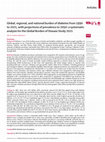
Background Diabetes is one of the leading causes of death and disability worldwide, and affects p... more Background Diabetes is one of the leading causes of death and disability worldwide, and affects people regardless of country, age group, or sex. Using the most recent evidentiary and analytical framework from the Global Burden of Diseases, Injuries, and Risk Factors Study (GBD), we produced location-specific, age-specific, and sex-specific estimates of diabetes prevalence and burden from 1990 to 2021, the proportion of type 1 and type 2 diabetes in 2021, the proportion of the type 2 diabetes burden attributable to selected risk factors, and projections of diabetes prevalence through 2050. Methods Estimates of diabetes prevalence and burden were computed in 204 countries and territories, across 25 age groups, for males and females separately and combined; these estimates comprised lost years of healthy life, measured in disability-adjusted life-years (DALYs; defined as the sum of years of life lost [YLLs] and years lived with disability [YLDs]). We used the Cause of Death Ensemble model (CODEm) approach to estimate deaths due to diabetes, incorporating 25 666 location-years of data from vital registration and verbal autopsy reports in separate total (including both type 1 and type 2 diabetes) and type-specific models. Other forms of diabetes, including gestational and monogenic diabetes, were not explicitly modelled. Total and type 1 diabetes prevalence was estimated by use of a Bayesian meta-regression modelling tool, DisMod-MR 2.1, to analyse 1527 location-years of data from the scientific literature, survey microdata, and insurance claims; type 2 diabetes estimates were computed by subtracting type 1 diabetes from total estimates. Mortality and prevalence estimates, along with standard life expectancy and disability weights, were used to calculate YLLs, YLDs, and DALYs. When appropriate, we extrapolated estimates to a hypothetical population with a standardised age structure to allow comparison in populations with different age structures. We used the comparative risk assessment framework to estimate the risk-attributable type 2 diabetes burden for 16 risk factors falling under risk categories including environmental and occupational factors, tobacco use, high alcohol use, high body-mass index (BMI), dietary factors, and low physical activity. Using a regression framework, we forecast type 1 and type 2 diabetes prevalence through 2050 with Socio-demographic Index (SDI) and high BMI as predictors, respectively. Findings In 2021, there were 529 million (95% uncertainty interval [UI] 500-564) people living with diabetes worldwide, and the global age-standardised total diabetes prevalence was 6•1% (5•8-6•5). At the super-region level, the highest age-standardised rates were observed in north Africa and the Middle East (9•3% [8•7-9•9]) and, at the regional level, in Oceania (12•3% [11•5-13•0]). Nationally, Qatar had the world's highest age-specific prevalence of diabetes, at 76•1% (73•1-79•5) in individuals aged 75-79 years. Total diabetes prevalence-especially among older adults-primarily reflects type 2 diabetes, which in 2021 accounted for 96•0% (95•1-96•8) of diabetes cases and 95•4% (94•9-95•9) of diabetes DALYs worldwide. In 2021, 52•2% (25•5-71•8) of global type 2 diabetes DALYs were attributable to high BMI. The contribution of high BMI to type 2 diabetes DALYs rose by 24•3% (18•5-30•4) worldwide between 1990 and 2021. By 2050, more than 1•31 billion (1•22-1•39) people are projected to have diabetes, with expected age-standardised total diabetes prevalence rates greater than 10% in two super-regions: 16•8% (16•1-17•6) in north Africa and the Middle East and 11•3% (10•8-11•9) in Latin America and Caribbean. By 2050, 89 (43•6%) of 204 countries and territories will have an age-standardised rate greater than 10%. Interpretation Diabetes remains a substantial public health issue. Type 2 diabetes, which makes up the bulk of diabetes cases, is largely preventable and, in some cases, potentially reversible if identified and managed early in the disease course. However, all evidence indicates that diabetes prevalence is increasing worldwide, primarily due to a rise in obesity caused by multiple factors. Preventing and controlling type 2 diabetes remains an ongoing challenge. It is essential to better understand disparities in risk factor profiles and diabetes burden across populations, to inform strategies to successfully control diabetes risk factors within the context of multiple and complex drivers. Funding Bill & Melinda Gates Foundation.

The Lancet
Background Diabetes is one of the leading causes of death and disability worldwide, and affects p... more Background Diabetes is one of the leading causes of death and disability worldwide, and affects people regardless of country, age group, or sex. Using the most recent evidentiary and analytical framework from the Global Burden of Diseases, Injuries, and Risk Factors Study (GBD), we produced location-specific, age-specific, and sex-specific estimates of diabetes prevalence and burden from 1990 to 2021, the proportion of type 1 and type 2 diabetes in 2021, the proportion of the type 2 diabetes burden attributable to selected risk factors, and projections of diabetes prevalence through 2050. Methods Estimates of diabetes prevalence and burden were computed in 204 countries and territories, across 25 age groups, for males and females separately and combined; these estimates comprised lost years of healthy life, measured in disability-adjusted life-years (DALYs; defined as the sum of years of life lost [YLLs] and years lived with disability [YLDs]). We used the Cause of Death Ensemble model (CODEm) approach to estimate deaths due to diabetes, incorporating 25 666 location-years of data from vital registration and verbal autopsy reports in separate total (including both type 1 and type 2 diabetes) and type-specific models. Other forms of diabetes, including gestational and monogenic diabetes, were not explicitly modelled. Total and type 1 diabetes prevalence was estimated by use of a Bayesian meta-regression modelling tool, DisMod-MR 2.1, to analyse 1527 location-years of data from the scientific literature, survey microdata, and insurance claims; type 2 diabetes estimates were computed by subtracting type 1 diabetes from total estimates. Mortality and prevalence estimates, along with standard life expectancy and disability weights, were used to calculate YLLs, YLDs, and DALYs. When appropriate, we extrapolated estimates to a hypothetical population with a standardised age structure to allow comparison in populations with different age structures. We used the comparative risk assessment framework to estimate the risk-attributable type 2 diabetes burden for 16 risk factors falling under risk categories including environmental and occupational factors, tobacco use, high alcohol use, high body-mass index (BMI), dietary factors, and low physical activity. Using a regression framework, we forecast type 1 and type 2 diabetes prevalence through 2050 with Socio-demographic Index (SDI) and high BMI as predictors, respectively. Findings In 2021, there were 529 million (95% uncertainty interval [UI] 500-564) people living with diabetes worldwide, and the global age-standardised total diabetes prevalence was 6•1% (5•8-6•5). At the super-region level, the highest age-standardised rates were observed in north Africa and the Middle East (9•3% [8•7-9•9]) and, at the regional level, in Oceania (12•3% [11•5-13•0]). Nationally, Qatar had the world's highest age-specific prevalence of diabetes, at 76•1% (73•1-79•5) in individuals aged 75-79 years. Total diabetes prevalence-especially among older adults-primarily reflects type 2 diabetes, which in 2021 accounted for 96•0% (95•1-96•8) of diabetes cases and 95•4% (94•9-95•9) of diabetes DALYs worldwide. In 2021, 52•2% (25•5-71•8) of global type 2 diabetes DALYs were attributable to high BMI. The contribution of high BMI to type 2 diabetes DALYs rose by 24•3% (18•5-30•4) worldwide between 1990 and 2021. By 2050, more than 1•31 billion (1•22-1•39) people are projected to have diabetes, with expected age-standardised total diabetes prevalence rates greater than 10% in two super-regions: 16•8% (16•1-17•6) in north Africa and the Middle East and 11•3% (10•8-11•9) in Latin America and Caribbean. By 2050, 89 (43•6%) of 204 countries and territories will have an age-standardised rate greater than 10%. Interpretation Diabetes remains a substantial public health issue. Type 2 diabetes, which makes up the bulk of diabetes cases, is largely preventable and, in some cases, potentially reversible if identified and managed early in the disease course. However, all evidence indicates that diabetes prevalence is increasing worldwide, primarily due to a rise in obesity caused by multiple factors. Preventing and controlling type 2 diabetes remains an ongoing challenge. It is essential to better understand disparities in risk factor profiles and diabetes burden across populations, to inform strategies to successfully control diabetes risk factors within the context of multiple and complex drivers. F
International Journal of Medical and Health Sciences Research, 2015
This study aims to evaluate the reliability, and construct validity of the Malaysian versions of ... more This study aims to evaluate the reliability, and construct validity of the Malaysian versions of parent and child report of Children Health survey for Asthma. Questionnaires were translated to Bahasa Malaysia using previously established guidelines, a cross sectional study design and methodology was used to obtain the data, the study was recruited 180 respondents (7-16 years old) who have been diagnosed as asthmatic and their parents, SPSS version 20 was used to determine the reliability and construct validity. The results showed that all scores of cronbach's alpha in the acceptable range ≥ 0.7. Both reliability and factor analyses reveal an acceptable reliability and a good construct validity of the scales.

Journal of Pharmacy & Bioresources, 2021
Malaria infection is a major public health problem in Nigeria. The present study explored patient... more Malaria infection is a major public health problem in Nigeria. The present study explored patients’ thoughts and feelings on uncomplicated malaria and its management practices in some primary healthcare (PHC) facilities of Plateau state, Nigeria. An in-depth interview was conducted on patients receiving treatment in some of the facilities in the state, who were recruited through purposive sampling method up to saturation point. All the information was audio-recorded and transcribed verbatim before analysis using the principles of thematic content analysis of inductive method. Generally, their views on malaria-related issues were categorised into four main themes based on their relevancies as: patients’ perceptions on malaria infection and anti-malarial drugs, the role of healthcare workers and family during treatment, medications taken and socio-economic-related factors, as well as their general views on healthcare facilities-related factors. The study showed patients’ perceptions o...

The Lancet Healthy Longevity
Background Benign prostatic hyperplasia is a common urological disease affecting older men worldw... more Background Benign prostatic hyperplasia is a common urological disease affecting older men worldwide, but comprehensive data about the global, regional, and national burden of benign prostatic hyperplasia and its trends over time are scarce. As part of the Global Burden of Diseases, Injuries, and Risk Factors Study (GBD) 2019, we estimated global trends in, and prevalence of, benign prostatic hyperplasia and disability-adjusted life-years (DALYs) due to benign prostatic hyperplasia, in 21 regions and 204 countries and territories from 2000 to 2019. Methods This study was conducted with GBD 2019 analytical and modelling strategies. Primary prevalence data came from claims from three countries and from hospital inpatient encounters from 45 locations. A Bayesian metaregression modelling tool, DisMod-MR version 2.1, was used to estimate the age-specific, location-specific, and yearspecific prevalence of benign prostatic hyperplasia. Age-standardised prevalence was calculated by the direct method using the GBD reference population. Years lived with disability (YLDs) due to benign prostatic hyperplasia were estimated by multiplying the disability weight by the symptomatic proportion of the prevalence of benign prostatic hyperplasia. Because we did not estimate years of life lost associated with benign prostatic hyperplasia, disabilityadjusted life-years (DALYs) equalled YLDs. The final estimates were compared across Socio-demographic Index (SDI) quintiles. The 95% uncertainty intervals (UIs) were estimated as the 25th and 975th of 1000 ordered draws from a bootstrap distribution. Findings Globally, there were 94•0 million (95% UI 73•2 to 118) prevalent cases of benign prostatic hyperplasia in 2019, compared with 51•1 million (43•1 to 69•3) cases in 2000. The age-standardised prevalence of benign prostatic hyperplasia was 2480 (1940 to 3090) per 100 000 people. Although the global number of prevalent cases increased by 70•5% (68•6 to 72•7) between 2000 and 2019, the global age-standardised prevalence remained stable (-0•770% [-1•56 to 0•0912]). The age-standardised prevalence in 2019 ranged from 6480 (5130 to 8080) per 100 000 in eastern Europe to 987 (732 to 1320) per 100 000 in north Africa and the Middle East. All five SDI quintiles observed an increase in the absolute DALY burden between 2000 and 2019. The most rapid increases in the absolute DALY burden were seen in the middle SDI quintile (94•7% [91•8 to 97•6]), the low-middle SDI quintile (77•3% [74•1 to 81•2]), and the low SDI quintile (77•7% [72•9 to 83•2]). Between 2000 and 2019, age-standardised DALY rates changed less, but the three lower SDI quintiles (low, low-middle, and middle) saw small increases, and the two higher SDI quintiles (high and high-middle SDI) saw small decreases. Interpretation The absolute burden of benign prostatic hyperplasia is rising at an alarming rate in most of the world, particularly in low-income and middle-income countries that are currently undergoing rapid demographic and epidemiological changes. As more people are living longer worldwide, the absolute burden of benign prostatic hyperplasia is expected to continue to rise in the coming years, highlighting the importance of monitoring and planning for future health system strain. Funding Bill & Melinda Gates Foundation.
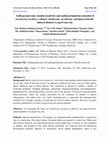
Functional Foods in Health and Disease, 2015
Background: Reishi (Ganoderma lucidum) is a well-known and popular edible mushroom eaten as veget... more Background: Reishi (Ganoderma lucidum) is a well-known and popular edible mushroom eaten as vegetables all over the world. It has been used as alternative medicine for long years in China, Korea, Japan, Malaysia, and in eastern Russia. It is reported to exhibit a number of medicinal properties including antitumor, antioxidant, immunomodulating, anti-inflammatory, hepatoprotective, and hypoglycemic activities due to the presence of bioactive polysaccharide. Glucocorticoids, prescribed for the treatment of arthritis to protect inflammation and reduce pain, can induce hyperglycemia or aggravate the hyperglycemic condition reaching to very high glucose levels in diabetic patients. However, no report has been published for its activity on glucocorticoid-induced diabetes. Objective: To investigate the effect of Ganoderma lucidum on alloxan- and glucocorticoid- induced diabetes in Long-Evans rats. Methods: Alloxan monohydrate (150 mg/kg) was intraperitoneally administered to Long-Evans r...

Journal of Pharmacology and Pharmacotherapeutics
A 26-year-old Malaysian woman (childbearing age) attended a private primary care clinic with a kn... more A 26-year-old Malaysian woman (childbearing age) attended a private primary care clinic with a known case of gastroesophageal reflux disease (GERD) and complained of persistent nausea and a few episodes of vomiting. She had no known drug allergy, no surgical history, no hospitalization in the last two years, was a non-smoker, and no history of drug or alcohol abuse. The patient was prescribed Tab metoclopramide 10 mg TDS and Tab ranitidine 150 mg BD for five days. About 30 min after oral administration of both medicines, her eyes rolled involuntary upward, leading to lateral deviation of the eyes, and mouth jaws clenched as if “dislocated jaws.” The patient was immediately brought into an emergency department (ED) of a public tertiary care hospital. A drug challenge test was done which resulted in the withdrawal of metoclopramide. The accompanied sister later disclosed that the patient had taken metoclopramide and ranitidine from a private clinic earlier in the day. The patient self...
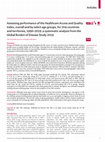
The Lancet Global Health
Background Health-care needs change throughout the life course. It is thus crucial to assess whet... more Background Health-care needs change throughout the life course. It is thus crucial to assess whether health systems provide access to quality health care for all ages. Drawing from the Global Burden of Diseases, Injuries, and Risk Factors Study 2019 (GBD 2019), we measured the Healthcare Access and Quality (HAQ) Index overall and for select age groups in 204 locations from 1990 to 2019. Methods We distinguished the overall HAQ Index (ages 0-74 years) from scores for select age groups: the young (ages 0-14 years), working (ages 15-64 years), and post-working (ages 65-74 years) groups. For GBD 2019, HAQ Index construction methods were updated to use the arithmetic mean of scaled mortality-to-incidence ratios (MIRs) and risk-standardised death rates (RSDRs) for 32 causes of death that should not occur in the presence of timely, quality health care. Across locations and years, MIRs and RSDRs were scaled from 0 (worst) to 100 (best) separately, putting the HAQ Index on a different relative scale for each age group. We estimated absolute convergence for each group on the basis of whether the HAQ Index grew faster in absolute terms between 1990 and 2019 in countries with lower 1990 HAQ Index scores than countries with higher 1990 HAQ Index scores and by Socio-demographic Index (SDI) quintile. SDI is a summary metric of overall development. Findings Between 1990 and 2019, the HAQ Index increased overall (by 19•6 points, 95% uncertainty interval 17•9-21•3), as well as among the young (22•5, 19•9-24•7), working (17•2, 15•2-19•1), and post-working (15•1, 13•2-17•0) age groups. Large differences in HAQ Index scores were present across SDI levels in 2019, with the overall index ranging from 30•7 (28•6-33•0) on average in low-SDI countries to 83•4 (82•4-84•3) on average in high-SDI countries. Similarly large ranges between low-SDI and high-SDI countries, respectively, were estimated in the HAQ Index for the young (40•4-89•0), working (33•8-82•8), and post-working (30•4-79•1) groups. Absolute convergence in HAQ Index was estimated in the young group only. In contrast, divergence was estimated among the working and post-working groups, driven by slow progress in low-SDI countries. Interpretation Although major gaps remain across levels of social and economic development, convergence in the young group is an encouraging sign of reduced disparities in health-care access and quality. However, divergence in the working and post-working groups indicates that health-care access and quality is lagging at lower levels of social and economic development. To meet the needs of ageing populations, health systems need to improve health-care access and quality for working-age adults and older populations while continuing to realise gains among the young. Funding Bill & Melinda Gates Foundation.
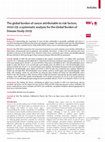
The Lancet
Background Understanding the magnitude of cancer burden attributable to potentially modifiable ri... more Background Understanding the magnitude of cancer burden attributable to potentially modifiable risk factors is crucial for development of effective prevention and mitigation strategies. We analysed results from the Global Burden of Diseases, Injuries, and Risk Factors Study (GBD) 2019 to inform cancer control planning efforts globally. Methods The GBD 2019 comparative risk assessment framework was used to estimate cancer burden attributable to behavioural, environmental and occupational, and metabolic risk factors. A total of 82 risk-outcome pairs were included on the basis of the World Cancer Research Fund criteria. Estimated cancer deaths and disability-adjusted life-years (DALYs) in 2019 and change in these measures between 2010 and 2019 are presented. Findings Globally, in 2019, the risk factors included in this analysis accounted for 4•45 million (95% uncertainty interval 4•01-4•94) deaths and 105 million (95•0-116) DALYs for both sexes combined, representing 44•4% (41•3-48•4) of all cancer deaths and 42•0% (39•1-45•6) of all DALYs. There were 2•88 million (2•60-3•18) risk-attributable cancer deaths in males (50•6% [47•8-54•1] of all male cancer deaths) and 1•58 million (1•36-1•84) risk-attributable cancer deaths in females (36•3% [32•5-41•3] of all female cancer deaths). The leading risk factors at the most detailed level globally for risk-attributable cancer deaths and DALYs in 2019 for both sexes combined were smoking, followed by alcohol use and high BMI. Risk-attributable cancer burden varied by world region and Socio-demographic Index (SDI), with smoking, unsafe sex, and alcohol use being the three leading risk factors for risk-attributable cancer DALYs in low SDI locations in 2019, whereas DALYs in high SDI locations mirrored the top three global risk factor rankings. From 2010 to 2019, global risk-attributable cancer deaths increased by 20•4% (12•6-28•4) and DALYs by 16•8% (8•8-25•0), with the greatest percentage increase in metabolic risks (34•7% [27•9-42•8] and 33•3% [25•8-42•0]). Interpretation The leading risk factors contributing to global cancer burden in 2019 were behavioural, whereas metabolic risk factors saw the largest increases between 2010 and 2019. Reducing exposure to these modifiable risk factors would decrease cancer mortality and DALY rates worldwide, and policies should be tailored appropriately to local cancer risk factor burden. Funding Bill & Melinda Gates Foundation.
The Lancet Infectious Diseases
Background The global burden of lower respiratory infections (LRIs) and corresponding risk factor... more Background The global burden of lower respiratory infections (LRIs) and corresponding risk factors in children older than 5 years and adults has not been studied as comprehensively as it has been in children younger than 5 years. We assessed the burden and trends of LRIs and risk factors across all age groups by sex, for 204 countries and territories. Methods In this analysis of data for the Global Burden of Diseases, Injuries, and Risk Factors Study (GBD) 2019, we used clinician-diagnosed pneumonia or bronchiolitis as our case definition for LRIs. We included International Classification of Diseases 9th edition codes 079.6, 466-469, 470.0, 480-482.8, 483.0-483.9, 484.1-484.2, 484.6-484.7, and 487-489 and International Classification of Diseases 10th edition codes A48.

The Lancet Public Health
Background Globally, transport and unintentional injuries persist as leading preventable causes o... more Background Globally, transport and unintentional injuries persist as leading preventable causes of mortality and morbidity for adolescents. We sought to report comprehensive trends in injury-related mortality and morbidity for adolescents aged 10-24 years during the past three decades. Methods Using the Global Burden of Disease, Injuries, and Risk Factors 2019 Study, we analysed mortality and disability-adjusted life-years (DALYs) attributed to transport and unintentional injuries for adolescents in 204 countries. Burden is reported in absolute numbers and age-standardised rates per 100 000 population by sex, age group (10-14, 15-19, and 20-24 years), and sociodemographic index (SDI) with 95% uncertainty intervals (UIs). We report percentage changes in deaths and DALYs between 1990 and 2019. Findings In 2019, 369 061 deaths (of which 214 337 [58%] were transport related) and 31•1 million DALYs (of which 16•2 million [52%] were transport related) among adolescents aged 10-24 years were caused by transport and unintentional injuries combined. If compared with other causes, transport and unintentional injuries combined accounted for 25% of deaths and 14% of DALYs in 2019, and showed little improvement from 1990 when such injuries accounted for 26% of adolescent deaths and 17% of adolescent DALYs. Throughout adolescence, transport and unintentional injury fatality rates increased by age group. The unintentional injury burden was higher among males than females for all injury types, except for injuries related to fire, heat, and hot substances, or to adverse effects of medical treatment. From 1990 to 2019, global mortality rates declined by 34•4% (from 17•5 to 11•5 per 100 000) for transport injuries, and by 47•7% (from 15•9 to 8•3 per 100 000) for unintentional injuries. However, in low-SDI nations the absolute number of deaths increased (by 80•5% to 42 774 for transport injuries and by 39•4% to 31 961 for unintentional injuries). In the high-SDI quintile in 2010-19, the rate per 100 000 of transport injury DALYs was reduced by 16•7%, from 838 in 2010 to 699 in 2019. This was a substantially slower pace of reduction compared with the 48•5% reduction between 1990 and 2010, from 1626 per 100 000 in 1990 to 838 per 100 000 in 2010. Between 2010 and 2019, the rate of unintentional injury DALYs per 100 000 also remained largely unchanged in high-SDI countries (555 in 2010 vs 554 in 2019; 0•2% reduction). The number and rate of adolescent deaths and DALYs owing to environmental heat and cold exposure increased for the high-SDI quintile during 2010-19. Interpretation As other causes of mortality are addressed, inadequate progress in reducing transport and unintentional injury mortality as a proportion of adolescent deaths becomes apparent. The relative shift in the burden of injury from high-SDI countries to low and low-middle-SDI countries necessitates focused action, including global donor, government, and industry investment in injury prevention. The persisting burden of DALYs related to transport and unintentional injuries indicates a need to prioritise innovative measures for the primary prevention of adolescent injury. Funding Bill & Melinda Gates Foundation.
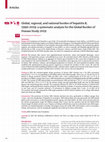
The Lancet Gastroenterology & Hepatology
Background Combating viral hepatitis is part of the UN Sustainable Development Goals (SDGs), and ... more Background Combating viral hepatitis is part of the UN Sustainable Development Goals (SDGs), and WHO has put forth hepatitis B elimination targets in its Global Health Sector Strategy on Viral Hepatitis (WHO-GHSS) and Interim Guidance for Country Validation of Viral Hepatitis Elimination (WHO Interim Guidance). We estimated the global, regional, and national prevalence of hepatitis B virus (HBV), as well as mortality and disability-adjusted life-years (DALYs) due to HBV, as part of the Global Burden of Diseases, Injuries, and Risk Factors Study (GBD) 2019. This included estimates for 194 WHO member states, for which we compared our estimates to WHO elimination targets. Methods The primary data sources were population-based serosurveys, claims and hospital discharges, cancer registries, vital registration systems, and published case series. We estimated chronic HBV infection and the burden of HBV-related diseases, defined as an aggregate of cirrhosis due to hepatitis B, liver cancer due to hepatitis B, and acute hepatitis B. We used DisMod-MR 2.1, a Bayesian mixed-effects meta-regression tool, to estimate the prevalence of chronic HBV infection, cirrhosis, and aetiological proportions of cirrhosis. We used mortality-to-incidence ratios modelled with spatiotemporal Gaussian process regression to estimate the incidence of liver cancer. We used the Cause of Death Ensemble modelling (CODEm) model, a tool that selects models and covariates on the basis of out-ofsample performance, to estimate mortality due to cirrhosis, liver cancer, and acute hepatitis B. Findings In 2019, the estimated global, all-age prevalence of chronic HBV infection was 4•1% (95% uncertainty interval [UI] 3•7 to 4•5), corresponding to 316 million (284 to 351) infected people. There was a 31•3% (29•0 to 33•9) decline in all-age prevalence between 1990 and 2019, with a more marked decline of 76•8% (76•2 to 77•5) in prevalence in children younger than 5 years. HBV-related diseases resulted in 555 000 global deaths (487 000 to 630 000) in 2019. The number of HBV-related deaths increased between 1990 and 2019 (by 5•9% [-5•6 to 19•2]) and between 2015 and 2019 (by 2•9% [-5•9 to 11•3]). By contrast, all-age and age-standardised death rates due to HBV-related diseases decreased during these periods. We compared estimates for 2019 in 194 WHO locations to WHO-GHSS 2020 targets, and found that four countries achieved a 10% reduction in deaths, 15 countries achieved a 30% reduction in new cases, and 147 countries achieved a 1% prevalence in children younger than 5 years. As of 2019, 68 of 194 countries had already achieved the 2030 target proposed in WHO Interim Guidance of an all-age HBV-related death rate of four per 100 000. Interpretation The prevalence of chronic HBV infection declined over time, particularly in children younger than 5 years, since the introduction of hepatitis B vaccination. HBV-related death rates also decreased, but HBV-related death counts increased as a result of population growth, ageing, and cohort effects. By 2019, many countries had met the interim seroprevalence target for children younger than 5 years, but few countries had met the WHO-GHSS interim targets for deaths and new cases. Progress according to all indicators must be accelerated to meet 2030 targets, and there are marked disparities in burden and progress across the world. HBV interventions, such as vaccination, testing, and treatment, must be strategically supported and scaled up to achieve elimination. Funding Bill & Melinda Gates Foundation.










Uploads
Papers by nahlah elkudssiah ismail